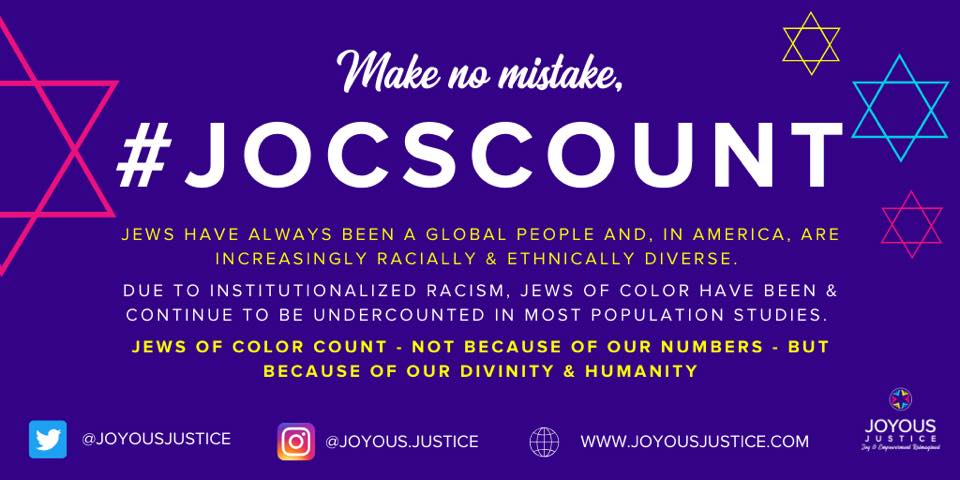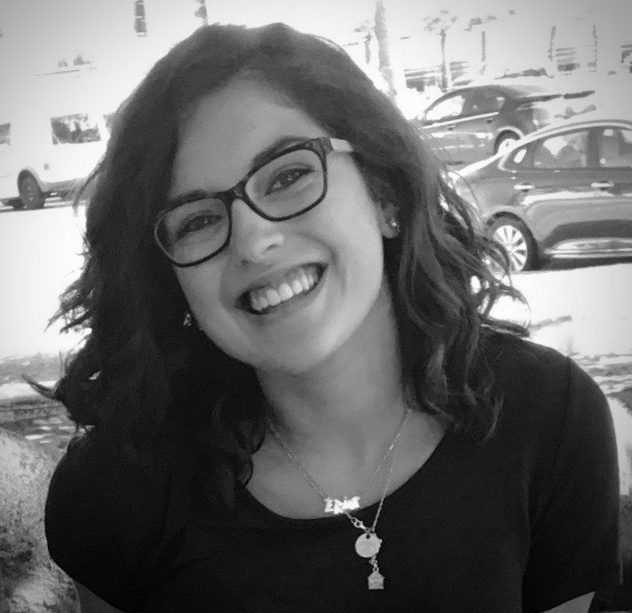 Photo courtesy of Ginna Green
Photo courtesy of Ginna Green Numbers have always held significance in Jewish culture, but without purpose, they can be harmful. This was borne out in a May 17 eJewish Philanthropy article, subsequently republished on The Forward’s website, titled, “How Many Jews of Color Are There?”
Written by American Jewish Year Book editors Arnold Dashefsky and Ira M. Sheskin, the article drew ire from Jews of Color (JOC) and Jewish social justice groups for reducing Jews of Color to a statistic, as opposed to seeing them as valued members of the community.
In response, activist April Baskin launched the hashtag #JOCsCount. By May 19, she, together with Ginna Green, Shahanna McKinney-Baldon and Abby Levine had created a sign-on letter opposing the article. The letter quickly went viral. To date, more than 2,500 American Jews and 200 organizations have signed the petition.
“Jews of Color count — not because of our numbers, but simply because of our divinity and humanity,” Baskin, a diversity, equity and inclusion consultant and former executive vice president of Audacious Hospitality at the Union of Reform Judaism, said in a statement to the Journal. “Now is the time to double-down on efforts to advance our vision of a vibrant, equitable, multiracial Jewish community.”
According to the American Jewish Population Project, Jews of Color make up at least 12% of the total Jewish population in the United States. Green, a political strategist, told the Journal that Dashefsky and Sheskin’s article was harmful because it included incomplete information and “cherry-picked” data.
“It would be great if we were counting all diversity,” she said. “What was so bothersome to me was that we don’t have an accurate count because the vast majority of studies that came before, over the last 30 years, have failed to ask the question in such a way where we can count on the data. The authors’ analysis was problematic from start to finish.”
“I want every person of color to walk into a Jewish setting and it’s assumed that they are Jewish. That’s what we would do if a white person walked into a Jewish setting. Right now it’s the opposite and that’s the problem.” — Marissa Tiamfook
Green referenced a May 2019 report by Ari Y. Kelman titled, “Counting Inconsistencies: An Analysis of American Jewish Population Studies With a Focus on Jews of Color,” which documents the many ways surveys have failed to ask Jews about race, ethnicity and language in order to create a well-rounded count of American Jews. Leaving out inquiries sways the number of Ashkenazi, Sephardi and Mizrahi Jews, Kelman wrote. In his rebuttal on eJewish Philanthropy, Kelman’s analysis “revealed that only 41% of Jewish community studies (36 of 89) conducted since the year 2000 even included any questions about race and ethnicity in the first place.”
Green, who converted in her early 20s, grew up in South Carolina and became interested in Judaism after learning about the Jews involved in the Civil Rights movement. She said she wants her four children to feel safe, seen and proud in their Jewish spaces because she knows they will experience hardships because of the of the color of their skin. “I knew that for a Jewish person of color, it isn’t a matter of if you encounter racism in the Jewish community, it’s when,” Green said.
McKinney-Baldon, director of EDOT, the Midwest Regional Jewish Diversity Collaborative and #JOCsCount co-organizer, works to promote racial and ethnic diversity in Jewish spaces and to disprove the stereotype that Jews live only in big cities.
“I’ve met a lot of People of Color who used to be Jewish but are not anymore because of the racism they faced in Jewish spaces,” McKinney-Baldon said. “What I’ve found over the years is folks do engage when we set up spaces that align with their priorities and contradict the ways they’ve felt marginalized in the past.”
Los Angeles resident Marissa Gee said that while she and her family have found a Jewish community to thrive in at IKAR, she remembers facing racism at her religious day school growing up. She signed the letter for her two black Jewish children so they can live in a more inclusive future.
“My goal is for me, my children, my friends, Jews of Color everywhere to walk into a synagogue, a Jewish organization or a Jewish event and it’s totally normal,” Gee said. “I want every person of color and families of color to walk into a Jewish setting and it’s assumed that they are Jewish. That’s what we would do if a white person walked into a Jewish setting. Right now, it’s the opposite and that’s the problem.”
Political activist and writer Carly Pildis signed the letter as an ally to JOCs.
“The [Jewish] communities need to be willing to take on the hard work in addressing inequity and institutionalized racism,” Pildis said. “[It’s] looking at our structure and asking ourselves at every level, ‘How do we be more actively anti-racist every day?’ If we don’t acknowledge where we are failing, we can’t move forward.”
The #JOCsCount initiative is not the first group to advocate for Jews of Color. Ilana Kaufman, who has done JOC advocacy work for decades, is the executive director of the Jews of Color Field Building Initiative and recently launched the Jews of Color Initiative COVID-19 Emergency Relief Fund for Individuals, which offers support to those experiencing financial hardship during the coronavirus pandemic.
Audrey Sasson, a Mizrahi Jew originally from Montreal, is the executive director at New York-based Jews for Racial and Economic Justice (JFREJ) and has been fighting on behalf of Jews of Color for many years. She signed the letter in solidarity.
“Especially in a time of crisis, it is not time to retreat into what is comfortable,” she said. “We know the people who are most disproportionately impacted by COVID-19 and we’re not seeing them. This week alone, with what happened in Minneapolis [where a white police officer was recorded using his knee to pin a black man to the street by the back of his neck; the man later died] Jews of Color in our community are grieving and in deep pain. We have to be showing up far more collectively to really build a multiracial, multi-ethnic community that can withstand the assaults on all of us.”
Multi-denominational temples, Bend the Arc, Hebrew College, HIAS, MAZON: A Jewish Response to Hunger, RespectAbility, T’ruah: The Rabbinic Call for Human Rights, and the Union for Reform Judaism are among the many Jewish organizations that also signed the letter.
“There are Jews of Color who are in spaces where we were not and we are not going anywhere,” Green said. “I think we will also be able to transform Jewish institutions. Part of transforming the Jewish community is two-fold. One of them is white Jews who really take on the task to be anti-racist and also Jews of Color being able to step into leadership roles and visibility in Jewish institutions.”
An earlier version of this story used the maiden name of Marissa Gee. It has been updated to include her married name.






















 More news and opinions than at a Shabbat dinner, right in your inbox.
More news and opinions than at a Shabbat dinner, right in your inbox.